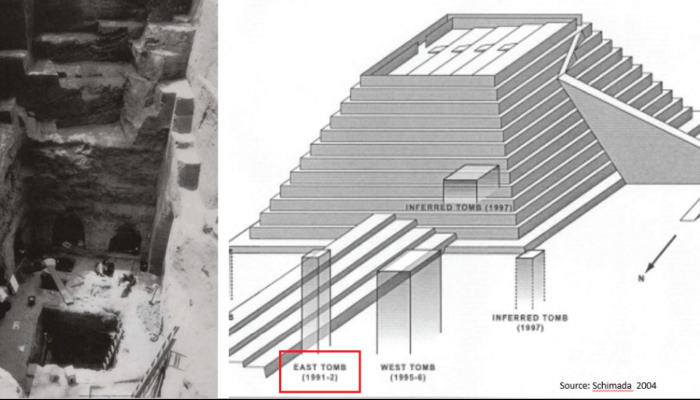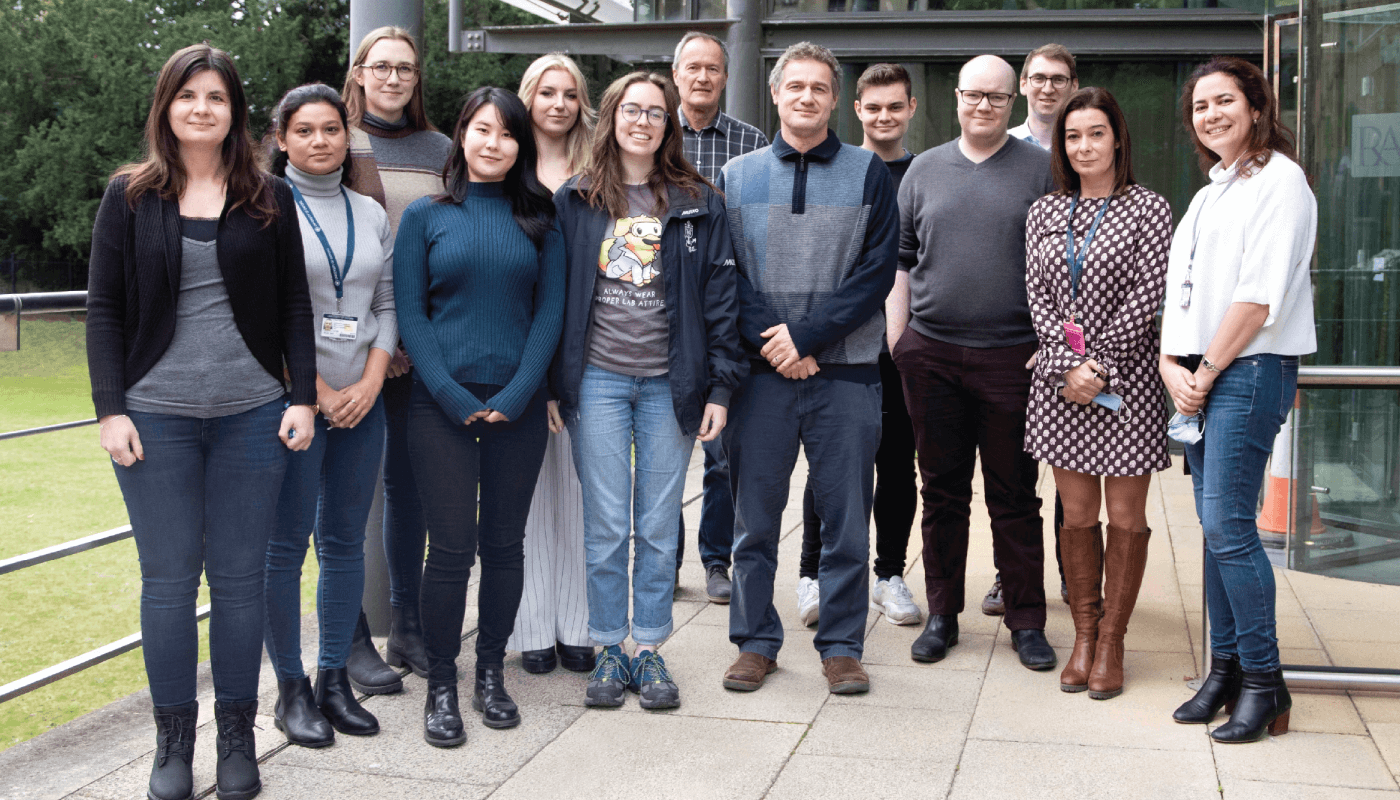Thirty years ago, archeologists excavated a gold mask from a Middle Sicán tomb in Peru. Covering the gold was an unusually well-preserved layer of scarlet-red paint – still visible 1000 years after it was applied by the Sicán people. Researchers quickly identified the pigment as cinnabar (a mercuric sulfide mineral), but the identity of the remarkably effective binder remained a mystery – that is until a team of researchers applied proteomics to the problem.
James McCullagh, professor of biological chemistry and Director of the Mass Spectrometry Research Facility in the Department of Chemistry at the University of Oxford, and co-author of the study, was fascinated by the project for two reasons. “First, from a chemical perspective, how is it that the red paint was able to bind to the gold surface for such a long time?” he asks. “And second, if we could reveal what the Sicáns were using in their paints, what might that say about them as a people and a culture?”
The project was initiated by Luciana Carvalho. Carvalho graduated in chemistry in Brazil and fell in love with archeology after a trip to Egypt. She went on to study for a degree in Egyptology and trained as an archeological conservator at UCL. There, Carvalho met Dr John Merkel, who was part of the archeological mission led by Prof Izumi Shimada that discovered the mask.
“In 2014 I was debating whether to stay at UCL or go to Oxford to research organic residues preserved in metal corrosion, and Dr Merkel handed me a paint sample from the mask,” says Carvalho. “He suggested that I go to Oxford analyze it as part of my PhD to try to solve the mystery of the binder. So that’s what I did.”
At first, Carvalho struggled to find the right specialists and analytical techniques to tackle the project. But she found the perfect collaborator in James McCullagh, who had started at Oxford applying MS in an archeological context. “I still have strong research links with the Research Laboratory for Archaeology and History of Art in Oxford, including Professor Robert Hedges, Emeritus Professor of Archaeological Science, who pioneered radiocarbon dating using accelerator mass spectrometry and isotopic analysis of archeological materials,” says McCullagh. “The analysis of archeological residues can provide some of the most fascinating analytical challenges due to their chemical complexity, state of degradation and the limited amount of material often available. It may not be clear what the sample contains and what we are looking for as in this case. A Sherlock Holmes approach may therefore be necessary – to gather as many relevant pieces of analytical information as possible that not only provide detailed chemical information about the object, but also enable archeological scientists make reasonable interpretations about how people interacted and used the material in the past.”

Asking the right questions
Initially, before joining McCullagh’s group, Carvalho characterized the red paint with Fourier-transform infrared spectroscopy (FTIR) to have an idea of its chemical fingerprint. The results indicated the presence of proteins. Carvalho also looked for resin markers in the sample using a common protocol for lipid analysis from porous ceramics – to no avail. Either they weren’t there or the sample was too small.
That’s where another member of the research team – lead author Elisabete Pires, who works in McCullagh’s department and focuses on proteomics – played a key role.
“Elisabete is a specialist in analyzing proteins from biological samples and she did a great job despite some challenges,” says Carvalho. As part of a proteomics analytical protocol, you initially measure the amount of total protein in the sample to calculate the amount of enzyme needed for digestion into peptides. “Initially, that wasn’t possible, so Elisabete had to adapt the protocol to make things work,” says Carvalho.
Next, Pires used specialist software to match recovered peptides from the red paint to proteins in various databases. The initial hypothesis was that the paint could contain milk, eggs, and/or resin which have all been used as paint binders in the past. But the initial untargeted protein search revealed the presence of blood in the red paint.
The team found matches to human blood and bird egg proteins, including immunoglobulin heavy chain, immunoglobulin G, serum albumin, and ovomucoid. However, identifying the specific species of bird proved difficult.
“There’s a big difference between having a match to a particular protein sequence that may be the same across many species, and having a match to a peptide that has a species-specific amino acid sequence.” says McCullagh. “The primary amino acid sequences of some proteins are the same between species, others differ in certain places – there’s some luck involved.”
The chicken or the duck?
Intriguingly, the initial search against the egg database gave strong matches for chicken proteins – in fact, there was a perfect match to a particular chicken subset. The problem? It is thought that chickens were brought to the region by the Spanish several centuries after the mask was buried.
“It’s fascinating,” says Carvalho. “Chicken bones that date back to a time before the arrival of the Spanish have been found in Chile, but similar evidence has not been found in Peru. The genomes of chickens are very similar to those of ducks, so we hypothesized that the paint contained duck egg. However, just because we have no evidence of chickens having made it to Peru before the colonizers doesn’t mean they weren’t there. In archeology, we have to create stories based on very small samples of what survives.”
McCullagh admits that the question of whether samples are representative is a problem for all archeologists. “When you ask questions about the past you have to be open to many possibilities. We can’t rule something out just because our current interpretation of the past is a certain way. More so than many other fields of study there is often only a very limited amount of material available so we must be careful about making general interpretations.”
The findings also raised further archeological questions about the significance of the human blood proteins found on the mask. The team needs data from other cinnabar-paint samples, such as from the skeleton found alongside the mask, and from other masks from the same region – and these are now the subject of follow up work. “If we could confirm that blood was used in all Sicán cinnabar paint, then we may be able to extrapolate that the Sicáns understood the importance of human blood as a requirement for life,” says Carvalho. “Perhaps the reason the cinnabar paint was used for elite objects, such as gold masks, is that they thought it was important for the rebirth of their leaders in the afterlife. And we know human sacrifice was common among Latin American cultures at that time…”
The location of the tomb raises other interesting questions, says Carvalho: “The tomb was actually flooded, which meant looters could not get to it. Archeologists had to wait for the dry season to be able to reach the main chamber where the mask was found. Obviously, the river must have been dry when the tomb was created, which makes one wonder how different the climate must have been then, and whether the demise of the civilizations in Latin America had something to do with a climatic event…”

The importance of preservation
“The challenge for archeological science is that it is a poorly funded discipline,” says Carvalho. “In an ideal world, we’d have access to the latest techniques but there’s a cost associated with access, both in terms of running a sample and the time it takes to process data.”
McCullagh notes how the technique one chooses (or has access to) drives a certain set of questions – and so the answers are not always the answers that are most useful. “GC-MS is used a lot for lipid analysis in archeological residue applications – but taking a lipid-centric view of residues by default, may not always be the right approach. LC-MS-based proteomics has been around for some time and is becoming increasingly sensitive and able to analyze smaller and smaller amounts of sample, and that lends itself very well to archeology – besides the cost.”
Proteomics has been applied in archeological contexts in recent years, but rarely for residue analysis. “It has been pioneered effectively for species analysis however – to look for unique peptides in bone fragments that indicate speciation, for example,” says McCullagh. “But it is rare to see proteomics used in archeology to look at residues – in fact, it has only become possible in recent years with expanding protein libraries. Luciana and Elisabete’s analysis has shown very convincingly that it can be an important tool in the toolbox for answering archeological questions beyond species identification of bone.
“I’m very fond of using multi-analytical protocols – borrowing from inorganic and organic chemistry – because these are artificial boundaries. The idea is to see how the data provided by one technique can link up with a different sort of data from another technique to give a holistic view of the sample,” says Carvalho. “Analytical techniques, especially in archeological contexts, can only give snapshots of the truth – not the whole truth.”
Mask image credit: Photo by Y. Yoshii & SAP




